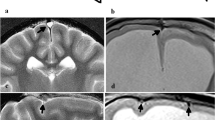Abstract
Transcranial Doppler ultrasonography (TCD) was performed on 14 patients with hydrocephalus (age range 1 day to 12 years old) before and after ventriculoperitoneal shunting. TCD was also perfomed with simultaneous intracranial pressure (ICP) measurements during ventricular taps through a reservoir in 7 patients. Measurements of the resistance index (RI)=(S-D)/S, peak systolic (S), enddiastolic (D) and time-averaged mean flow velocities were made. After ventricular taps and ventriculoperitoneal shunting there was a significant decrease in RI in all patients. This was due to a greater increase in D compared to S, which suggests a decreased distal cerebrovascular resistance. There was a significant correlation between RI and ICP in the older infants and children and in individual neonates. Successful cerebrospinal fluid diversion reduces ICP and cerebrovascular resistance, thus improving cerebral perfusion. The RI is a reliable index for serial monitoring of cerebrohaemodynamic change in patients with hydrocephalus.
Similar content being viewed by others
References
Aaslid R, Markwalder TM, Nornes H (1982) Noninvasive transcranial Doppler ultrasound recording of flow velocity in basal cerebral arteries. J Neurosurg 57:769–774
Archer LNJ, Evans DH, Patton JY, Levene MI (1986) Controlled hypercapnia and neonatal cerebral artery Doppler ultrasound waveforms. Pediatr Res 20:218–221
Bada HS, Hajjar W, Chua C, Sumner DS (1979) Noninvasive diagnosis of neonatal asphyxia and intraventricular haemorrhage by Doppler ultrasound J Pediatr 95:775–779
Bishop CCR, Powell S, Rutt D, Browse NL (1986) Transcranial Doppler measurement of middle cerebral artery blood flow velocity: a validation study. Stroke 17:913–915
Bode H, Wais U (1988) Age dependance of flow velocities in basal cerebral arteries. Arch Dis Child 63:606–611
Chadduck WM, Seibert JJ (1989) Intracranial duplex Doppler: practical uses in pediatric neurology and neurosurgery. J Child Neurol 4:S77-S86
Davson H, Welch K, Segal MB (1987) General features of hydrocephalus. In: Davson H, Welch K, Segal MB (eds) The physiology and pathophysiology of the cerebrospinal fluid. Churchill Livingstone, Edinburgh London Melbourne, pp 783–805
Finn JP, Quinn MW, Hall-Craggs MA, Kendall BE (1990) Impact of vessel distortion on transcranial Doppler velocity measurements: correlation with magnetic resonance imaging. J Neurosurg 73:572–575
Hassler W, Chioffi F (1989) CO2 reactivity of cerebral vasospasm after aneurysmal subarachnoid haemorrhage. Acta Neurochir (Wien) 98:167–175
Hill A, Volpe JJ (1982) Decrease in pulsatile flow in the anterior cerebral arteries in infantile hydrocephalus. Pediatrics 69:4–7
Hill A, Perlman JM, Volpe JJ (1982) Relationship of pneumothorax to occurrence of intracranial haemorrhage in the premature newborn. Pediatrics 69:144–149
Kaiser AM, Whitelaw AGL (1985) Cerebrospinal fluid pressure during posthaemorrhagic ventricular dilatation in newborn infants. Arch Dis Child 60:920–924
Kirkpatrick M, Engleman H, Minns RA (1989) Symptoms and signs of progressive hydrocephalus. Arch Dis Child 64:124–128
Kirsch JR, Traystman RJ, Rogers MC (1985) Cerebral blood flow measurement techniques in infants and children. Pediatrics 75:887–894
Klingelhofer J, Conrad B, Benecke R, Sander D, Markakis E (1988) Evaluation of intracranial pressure from transcranial Doppler studies in cerebral disease. J Neurol 235:159–162
Leggate JRS, Baxter P, Minns RA, Steers AJW, Brown JK, Shaw JF, Elton RA (1988) Role of a separate subcutaneous cerebrospinal fluid reservoir in the management of hydrocephalus. Br J Neurosurg 2:327–337
Lui K, Hellman J, Sprigg A, Daneman A (1990) Cerebral blood-flow velocity patterns in post-haemorrhagic ventricular dilatation. Child's Nerv Syst 6:250–253
Minns RA, Engleman HM, Stirling H (1989) Cerebrospinal fluid pressure in pyrogenic meningitis. Arch Dis Child 64:814–820
Perlman JM, Hill A, Volpe JJ (1981) The effect of patent ductus arteriosus on flow velocity in the anterior cerebral arteries: ductal steal in the premature newborn infant. J Pediatr 99:767–771
Pourcelot L (1975) Applications cliniques de l'examen Doppler transcutane. In: Peronneau P (ed) Velocimetre ultrasonore Doppler. INSERM, Paris, p 213
Rosenkrantz TS, Oh W (1982) Cerebral blood flow velocity in infants with polycythaemia and hyperviscosity: effects of partial exchange transfusion with plasmanate. J Pediatr 101:94–98
Seibert JJ, McCowan TC, Chadduck WM, Adametz JR, Glasier CM, Williamson SL, Taylor BJ, Leithiser RE, McConnell JR, Stansell CA, Rodgers AB, Corbitt SL (1989) Duplex pulsed Doppler US versus intracranial pressure in the neonate: clinical and experimental studies. Radiology 171:155–159
Shapiro K, Fried A, Marmarou A (1985) Biomechanical and hydrodynamic characterization of the hydrocephalic infant. J Neurosurg 63:69–75
Van Bel F, Van de Bor M, Baan J, Stijnen T, Ruys JH (1988) Blood flow velocity pattern of the anterior cerebral arteries —before and after drainage of posthaemorrhagic hydrocephalus in the newborn. J Ultrasound Med 7:553–559
Wozniak M, Mclone DG, Raimondi AJ (1975) Micro- and macrovascular changes as the direct cause of parenchymal destruction in congenital murine hydrocephalus. J Neurosurg 43:535–545
Author information
Authors and Affiliations
Rights and permissions
About this article
Cite this article
Goh, D., Minns, R.A., Pye, S.D. et al. Cerebral blood flow velocity changes after ventricular taps and ventriculoperitoneal shunting. Child's Nerv Syst 7, 452–457 (1991). https://doi.org/10.1007/BF00263188
Received:
Issue Date:
DOI: https://doi.org/10.1007/BF00263188




